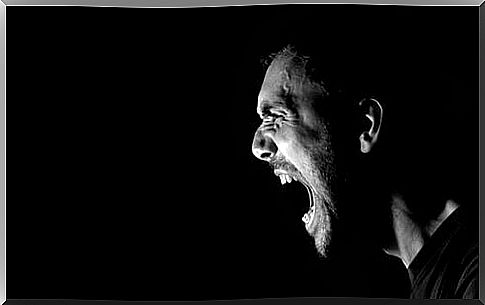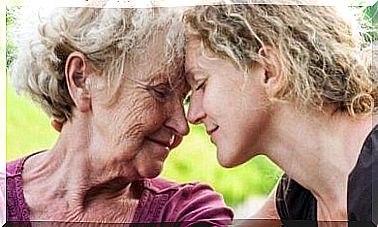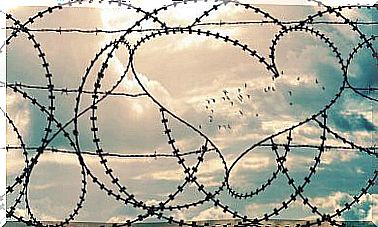Causes Of Aggression In Human Beings

Violence is a social interaction based on a specific way of relating: aggression. Despite its negative undertones, the truth is that it is deeply rooted in our society, and is and has been a key cog in the development of our civilization. Are these the causes of aggression?
Aggression and violence occur to a greater or lesser extent in virtually all human beings. For example, this is most noticeable in that part of the population who like films with violent themes. This wide response means that there is a rather varied catalog.
Furthermore, all peoples, including civilians, need the police and the army. This could be due to the urge of many human beings to solve problems through violent solutions.
Types of aggression: affective and instrumental
Some define aggression as a behavior that hurts another living being. Other authors, such as Berkowitz, add intentionality to this definition by considering aggression as a conduct whose intention is to harm.
Trying to attack another person can be an end in itself, that is, the goal is for the person to suffer, or to achieve something through that aggression. The latter is usually the most common. Based on this, we can distinguish between two types of aggression:
- Affective aggression : the person attacks on the basis of affection. The main goal is to harm someone else. Aggression is usually based on impulse and is not premeditated.
- Instrumental aggression : the person attacks for other purposes, which can be very varied: to avoid being harmed, that is, as self-defense; material benefits (stealing from someone); finally, symbolic benefits, for example being considered strong in the social circle.
Possible causes of aggression
Being the result of frustration, instinct, or an inevitable rush of energy (Miller, 1939), people are more likely to attack in certain situations.
These situations do not have to do with the people we are confronted with or with what they have done to us: they have to do with environmental factors.
Elements such as temperature or overcrowding will cause more aggressive behavior. We describe the four causes of aggression.
Transfer of emotions
In his arousal transference theory, Zillmann argues that emotional activation before the moment that causes aggression is a determining factor for that person in choosing to attack or not.
According to Zillmann, a person not only attacks due to the non-specific activation and cognitive processes that are generated in the emotional situation that one is experiencing, but it can also be a consequence of a past situation. His theory is that part of the activation of the previous emotion is transferred to the new situation.
This seems intuitive. However, it appears that when a person leaves a situation that activated them emotionally, that activation diminishes and eventually disappears.
Although the person has stopped feeling that activation, the truth is that he is more likely to attack than a person who has not been activated before; that is, it is like a kind of echo, which can return to the same state more quickly.
This means that in the presence of something angering us, the emotional activation that comes from that anger will add to the previous activation, intensifying the response we give.
It is important to say that the previous emotional activation does not have to be necessarily negative. If you have felt a very intense happiness before, that activation will likewise carry over to the next angry reaction, exacerbating it.
In research on aggression, in fact, people activated themselves through exercise and the results were the same.
Temperature: heat among the causes of aggression
With expressions such as “having a heated discussion” we observe how the relationship between aggression and temperature is something deeply rooted socially.
Anderson argued that heat is a source of adverse sensations that increase the likelihood of an aggressive response. Likewise, this can also be applied at low temperatures.
Baron and Richardson’s (1977) model of negative affective flight proposes that it is discomfort that generates heat; which would explain why in many cases people attack when it’s too hot.
According to this theory, if the perceived negative affect is moderate, the person will attack. If negative affect is excessively high, escape behavior will occur, reducing the likelihood of aggression.
Finally, the neo-association cognitive model argues that with high temperatures, negative thoughts and even aggression prevail. This occurs regardless of the presence or absence of the causes to which the aggression is attributed.
Noise causes stress and aggression
Another determining factor in which people attack is noise. Excessive noise has been associated with physical and mental disorders, stress and performance problems.
They are also activated with other very interesting processes such as the decrease in helping behaviors, and what concerns us, the increase in aggressive behaviors.
Authors such as Geen and McCown (1984) have carried out various experiments. They showed that people subjected to high levels of noise attacked more than those who had previously found themselves in contexts of silence.
Baron and Richardson (1977) include an interesting variable: control. While it is true that noise also increases aggressive behaviors, when the person believed they could control adverse noise, their aggressive behavior was inferior to that of those who felt helpless.

Possible causes of aggression: overcrowding and control measures
The relationship between overcrowding and aggression is not entirely clear. Ruback and Patnaik (1989) have studied aggression in crowded contexts.
They concluded that the aggressive behavior was not entirely motivated by the aversion to overcrowding, but by the lack of control that the individual felt in the situation. Individuals who found themselves in crowded areas tried to gain control through vandalism.
Although crowding is related to psychological processes such as performance or mental health, the relationship to aggression is not entirely clear.
Authors such as Bagley (1970) argue that it is not being in a crowded place that encourages aggressive behavior, but other elements relating to the context.
Conclusions
Apparently several aspects can lead people to attack or, conversely, to stop doing it. The fact that these four elements are in the situation does not determine that the aggression will take place; rather we could say that it favors it.
Aggression, therefore, is not justified when it is forty degrees, even if the temperature is a risk factor.
Other factors, such as the conduct of the individuals we interact with, determining cultural values, such as honor, levels of emotional management or the mechanisms of socialization of violence in the place where we live are further causes of aggression.









